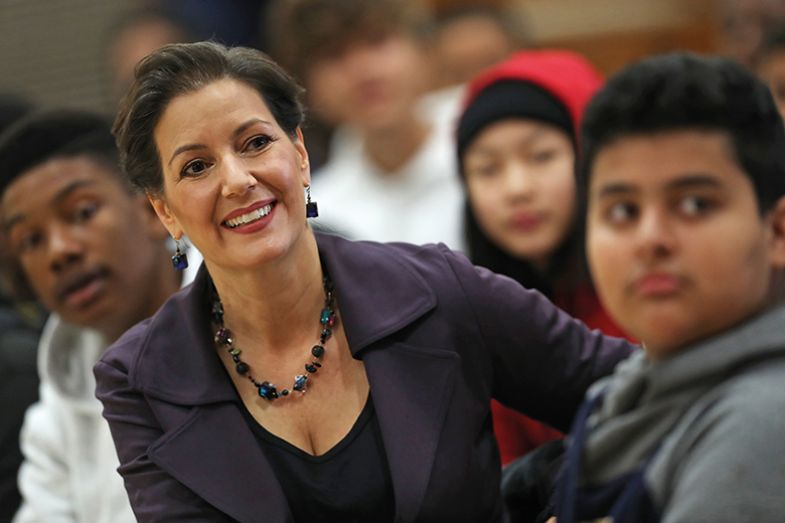The Children’s Fairyland amusement park in Oakland, California is busy on a sunny Saturday morning. Kids race through the Alice in Wonderland tunnel and the Old Woman’s Shoe while parents try to keep up. But if you go down to the Emerald City Stage (via the Yellow Brick Road, of course) and expect to find the usual toddler story time, you’re in for a big surprise.
Instead, there is some serious early childhood development and higher education access policy in the air, softened by music, balloons and bubbles. Children and parents watch Oakland’s mayor, Libby Schaaf (pictured below), officially launch “Brilliant Baby”, which aims to provide each of the 2,200 babies born into poverty every year in the city with a $500 (£375) college savings account.
Brilliant Baby is one part of the Oakland Promise, a multifaceted programme started by Schaaf and education partners in the city that aims to triple, by 2025, the number of children from the city’s public high schools who go on to obtain college degrees: in 2016 just 10 per cent did.
So central is the Oakland Promise to Schaaf’s policy platform that in November she hopes to ballot the city’s residents over raising their taxes, which could help fund the scheme.
Oakland, a port city where rows of giant white cranes unload the vast container ships that cruise under the Golden Gate Bridge from the Pacific, is historically more working-class and ethnically diverse than San Francisco, its glamorous neighbour across the bay. In recent decades, Oakland has been the centre of northern California’s African American population, but it now has growing Asian American and Latino communities, too.
A short walk across town from Children’s Fairyland, homeless people live in tents pitched beneath a flyover, evidence of a housing and homelessness crisis across the Bay Area, where Silicon Valley’s wealth has created a spiral of rising house prices and rents.
Donald Trump told The New York Times during the 2016 presidential election campaign: “There are places in America that are among the most dangerous in the world. You go to places like Oakland.” Schaaf, a Democrat, retorted on Twitter that “the most dangerous place in America is Donald Trump’s mouth”.
A political aeon ago, in 2012, Barack Obama described college education as “an economic imperative that every family in America has to be able to afford”. This conviction was later reflected in “America’s College Promise”: a federal programme that he intended to offer two years of free community college for everyone.
Obama’s vision didn’t outlast its collision with Republicans in Congress, but state and city governments across the US, along with non-profit organisations, have started their own “college promise” programmes, offering varying combinations of student support and tuition fee relief.
The Oakland Promise goes well beyond a free tuition pledge, and those who work on it believe that its scale and “cradle to career” approach make it unique and a potential model for a future governor of California or elsewhere to replicate statewide. Indeed, the challenge being taken up by Oakland – using education policy to alleviate poverty – is relevant across the entire globe.
Oakland’s city centre has a cluster of fine early 20th-century brick high-rises, among which is City Hall – an ornate Beaux Arts building reputed to have been the tallest edifice west of the Mississippi when built. In her office there, Schaaf tells Times Higher Education that there are two “unique” aspects to the Oakland Promise. “One is the comprehensive nature; that, literally, it starts at birth,” she says. The other is “a real focus not just on the skills needed for college success, not just the resources for college success, but the role of hope and expectation, of school culture and of student identity as a scholar”.

Along with Brilliant Baby, which tops up the college savings accounts for children born into poverty with more funds if parents attend financial coaching sessions, there are three other sections to the programme. “Kindergarten to College” aims to create a “college-going culture” in every elementary school and to provide all public kindergarten students with a college savings account seeded with $100, regardless of their parents’ income. Hubs in middle and high schools called “Future Centers” encourage and help students to develop college and career plans. And the “College Scholarship and Completion” programme provides not just scholarships but peer-to-peer mentoring and other “persistence support” to ensure that students complete their college courses and graduate.
Why make increasing the number of university graduates from the city such a priority? Schaaf says that “if I could do only one thing as the mayor of Oakland, it is this. And that is because if my children [in Oakland] are equipped to take advantage of the incredible economic opportunities in this region, it will solve nearly all my other urban challenges: poverty, economic development, crime. We know that a college education is the most certain ticket out of poverty.”
Schaaf highlights the importance of support for students while they are in higher education. “A lot of people know that a lot of our children drop out of high school, and a lot of people know that a lot of our children are not going to college. I don’t think people are sufficiently aware of how many of those students – particularly low-income, firstgeneration students – who persist all the way to getting into college end up dropping out,” she says.
The Oakland Promise is midway through a four-year pilot, with about 1,000 students who have received support now in college. Early results do indeed show promise. In 2017, students at Oakland Promise high schools reported applying to at least one postsecondary institution at a rate of 88 per cent, compared with 77 per cent at other schools. Significant rises in college enrolment of Latino and African American students at Oakland Promise schools have also been reported.
Around $34.5 million has been raised for the pilot, the majority paid for by donors. Philanthropy “can play a very powerful role in getting government to change the way it acts”, Schaaf says. “Because, I’ll be honest with you, I am tired of programmes. What excites me about the Oakland Promise is that it’s not just another programme: it is changing the way that we deliver education and early childhood support to every child in this city, not just the ones lucky enough to get in ‘a programme’.”
The mayor also hopes that philanthropists will contribute to a “$50 million quasi-endowment”, topping up $30 million a year in revenue from a $198 a year property tax rise that will “create a long-term funding stream to support the Oakland Promise” and pre-school education if voters approve it in a potential November ballot.
California’s Proposition 13 rule requires increases in many types of taxes at state or local level to be approved by a two-thirds electoral majority. But although the pilot is only half complete, “we believe we already have such strong evidence [of success] that we are prepared to take our case to the voters”, Schaaf says.
The mayor has plenty on her plate. In March this year, she warned immigrants living in Oakland about upcoming raids by federal immigration agents, leading Trump to label her actions a “disgrace” and prompting him to call on the US attorney general to consider prosecuting her on an obstruction of justice charge. She responded with a Washington Post article in which she said that it was her duty “to call out this administration’s anti-immigrant fearmongering for what it is: a racist lie”.
All of which goes to confirm the high profile and clout enjoyed by city mayors in the US. That is also evident in the Oakland Promise, which has seen Schaaf range much further into education policy than previous mayors, with 17 members of staff from various organisations now working on the scheme. David Silver, Schaaf’s director of education, was hired to work on the Oakland Promise from College Track, a non-profit organisation that prepares low-income children to enter, and graduate from, four-year colleges.
Silver stresses that addressing that challenge is not just about the sums of money involved in the savings accounts or scholarships. In fact, research suggests that the key element is to inculcate a “college-bound mentality”.
But, of course, money is necessary to support that culture shift. Silver says there will be “some equity-based scholarships”, from organisations such as the East Bay College Fund, a non-profit that supports low-income students with scholarships and mentors, which works with the Oakland Promise. But the universal elements of the Oakland Promise reflect the fact that existing scholarship offers targeted to low-income students often go begging because few realise they exist.

The plan is for the full scheme, post-pilot, to offer scholarships of between $2,000 and $4,000, with the exact distribution of awards yet to be decided. Students who enrol at Peralta, a network of community colleges in the East Bay, will not have to pay anything for their first semester, regardless of financial need. And if California enacts its bill, signed by governor Jerry Brown last year, to make the first year of community college free for all Californian students, the Peralta students will get an additional free semester.
The scheme also makes additional financial aid available for books, travel and other expenses. It has 29 university partnerships, including with seven historically black colleges, plus the California State University, East Bay (which offers guaranteed enrolment for any student from Oakland, conditional on their meeting an attainment threshold) and the University of California campuses of Berkeley, Santa Cruz and Davis. At partner institutions, new Oakland Promise students meet regularly with peers who have been through the programme: a vital element in ensuring that they complete their course and graduate.
In principle, students can take their scholarship money to any institution in the country. What if they never return to Oakland? According to Maggie Croushore, project director, communications and sustainability for the Oakland Promise, “Oakland pride is real…so people do want to come back. Because of the retreats [which bring together mentors and students and aim to maintain a connection to the Oakland Promise and the city], because of the mentoring, because of feeling a part of this movement…students are more likely to come back and serve their community because they feel so deeply invested in it.”
Some college promise schemes are more than a decade old: Michigan’s Kalamazoo Promise – in which anonymous donors pledge to pay up to 100 per cent of in-state college tuition costs for graduates of public high schools in the city of Kalamazoo – dates back to 2006. But the majority of programmes have sprung up recently, and take a variety of forms. Tennessee’s Republican governor, Bill Haslam, made his the first state to offer high school seniors free community college with the Tennessee Promise in 2014, extending that offer to adults in the state in 2017. Also in 2017, the state of New York made all public higher education institutions tuition-free for students from families earning less than $125,000 a year.
Eloy Ortiz Oakley, chancellor of the California Community Colleges System, was involved in the Long Beach College Promise as president of that community college district. He says that the 2007-09 recession and cuts in public higher education precipitated a desire in some cities and states to take “more control of the public education systems in their community”. And after the failure of Obama’s federal promise, “communities throughout the country, and in California specifically, took off with that idea…and created their own [schemes]”.
Where “once America debated whether high school should be universal and free – we’d realised that it should, because that’s what the economy demanded”, now the nation needs to regard “at least one or two years of community college, or college, as the new default. And we should make that universally available,” says Oakley.
The national College Promise Campaign defines a college promise in similar terms: as a commitment to “make the first two years of community college – at a minimum – as universal, free, and accessible as high school”. The campaign has identified more than 200 programmes across 41 states, its 2017 annual report says.
Martha Kanter, executive director of College Promise and formerly Obama’s lead official on higher education as undersecretary in the Department of Education, says that Oakland is not alone in taking a “cradle to career” approach. Along with Indiana’s Wabash County Promise , she highlights projects from the national Say Yes to Education programme in Buffalo and Syracuse, New York. That initiative, launched in 2008, supports citywide approaches encompassing tutoring and counselling for public school students, through to free tuition at in-state public colleges and universities.

But can college promise campaigns fulfil their promises? The campaigns are based on a couple of foundational principles – that degrees lead to decent jobs and that cities, states or nations with more graduates have stronger economies. Those principles are already questioned by some and could be definitively shattered in future as artificial intelligence transforms employment.
But Kanter says that post-secondary education of all kinds “will yield higher earnings, less reliance on government subsidies, greater health and stronger communities”. Unequal earnings returns to graduates of different institutions – often raised by those who believe that too many go into higher education – are a symptom of hugely varying institutional resource levels, rather than of an “oversupply” of graduates, Kanter argues. She highlights a 2015 analysis by the Public Policy Institute of California that found that, by 2030, the state “will fall about 1.1 million college graduates short of economic demand if current trends persist”.
“The information explosion makes it imperative for people to keep learning throughout their lives, as they will need to…move across various fields as their careers change,” Kanter says. “It’s easy to make pronouncements about the future of work; much harder to design or redesign well-researched, integrated birth-through-life interventions and incentives for families, as [some] Promise initiatives are doing.”
Asked if Oakland is in effect stepping in to address failures of state and federal government, Schaaf is unequivocal. “Yes, we are. There’s a reason why mayors are a good place to start. Because we live in our cities every day. We touch and feel the failures of government every day.” Cities, being relatively “small and nimble”, can demonstrate “transformational change” and thus be “experimental labs for states, for the nation”, she says. The drive to a California-wide minimum wage “started in cities”, she adds.
Schaaf highlights the fact that Oakland “is in the middle of the region with the best economic opportunities: Silicon Valley, San Francisco”. But Oakland children “are not being prepared to take advantage of those opportunities. It is shameful.” She goes on to say: “I can’t wait four years for there to be someone new in the White House [to tackle the problem].”
Oakland is “building a movement”, Silver adds. More than 1,000 individuals, including teachers and parents, are involved with the programme, so “it’s not about one person: it’s about everyone wanting it, from the grass roots. We’re talking about something big: serving 100,000 kids…having close to 50,000 kids being in college with early college scholarships.” As such, the Oakland Promise is “something that really can transform a generation”.
If Schaaf can break through the Proposition 13 barrier – and the early polling was positive, even without campaigning, she says – she looks forward to seeing her city and her state ultimately save money on “the healthcare costs, the criminal justice costs, the social benefits costs: all the things government has to fund when we fail to produce the most able adults”. Far better, she thinks, to “invest upfront in the capabilities of our children, to ensure they are the most productive, amazing adults that you would want living in your community”.
POSTSCRIPT:
Print headline: Municipal bonds
Register to continue
Why register?
- Registration is free and only takes a moment
- Once registered, you can read 3 articles a month
- Sign up for our newsletter
Subscribe
Or subscribe for unlimited access to:
- Unlimited access to news, views, insights & reviews
- Digital editions
- Digital access to THE’s university and college rankings analysis
Already registered or a current subscriber?








